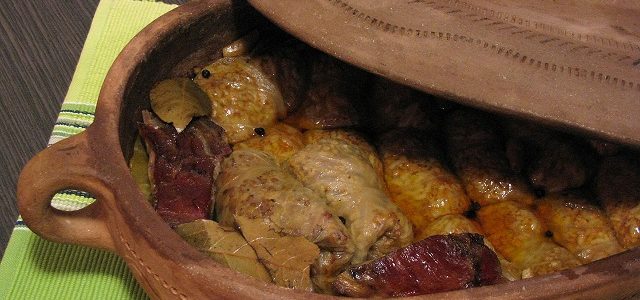
Do you know your ćevapčići from your ražnjići or your sarma from your kavurma? And if you are familiar with these Serbian specialities, how would you explain them in English?
It is no simple matter, and judging by the English translations of most restaurant menus in Serbia, restaurateurs have trouble too. Any time you eat out in Serbia you can expect free entertainment in the form of badly mangled English translations of Serbian dishes (and indeed dishes from most other parts of the world!), especially those where the restaurateur was foolish enough to resort to Google Translate. Here are just a few genuine examples we collected during a very quick browse through the English menus of some Serbian restaurants. These include some of the top eating spots in Belgrade, which shall remain nameless – for now:
- “Egg on the eye”: a literal translation of the Serbian expression meaning fried egg, “sunny side up”, often used jokingly but also seen on actual restaurant menus on occasion.
- “Omelette, at pleasure”: (another menu we found has “Omelette at choise”!) – an attempt at translating Omlet po želji, meaning that the omelette can be prepared according to your wishes – “Omelette, made to order” or “with your choice of filling”.
- “Catfish in Smederevian way”: presumably the catfish is not in anyone’s way, rather, it is prepared after the fashion of the town of Smederevo. We are not too sure about this adjectival form Smederevian, but we’ll let it pass – though we might perhaps rather say “Catfish, Smederevo-style”.
- “Gilt-bead”: since this was a translation of the fish orada (sparus aurata), one assumes they meant “Gilt-head bream”. But then probably no-one knows what that is anyway, so it might as well be gilt-bead!
- “Domestic Platter – mix of domestic cold cuts and cheeses…”: this is a very common one, where they have struggled over the word domaći and opted (incorrectly) for “domestic”, when the word really means something like “traditional, home-made” etc.
- “Smoke lion of pork” (dimljena vešalica): so is it lion or pork?!
- “Gypsys spit” (Ciganski ražanj): apart from being misspelt, the translation of this dish is not so much wrong as unfortunate. Indeed, even where menu items are translated “correctly” they often do not sound entirely appetising (see our second principle below). Here of course they meant something along the lines of “Meat on the spit, gypsy-style” or “Spit-roast meat, gypsy-style”.
- “Bekendex”, “hemendex” – Clue: it’s NOT a type of exterior paint! OK, you’ll never get this, but if we tell you “bekendex” is “bacon and eggs” then you can probably guess at “hemendex”, too!
These are perhaps some of the more extreme examples, but generally it is obvious that most restaurants do not seek professional assistance in translating their menus into English (well, they don’t seek ours, anyway!) and many English renditions of dishes are clumsy at best.
How we translate foods
There are several principles involved in translating the names of foods that we feel are important:
1) the translation must accurately convey the exact ingredients contained in the dish. This is very important from the customer’s point of view – the customer is not going to be happy if they get pork instead of chicken, or if they hate mushrooms but mushrooms are not mentioned or accurately translated in the menu item. They could even have a serious allergy to a particular food not mentioned on the menu!
2) the dish needs to sounds appetising – it’s no good the dish being translated accurately if it sounds awful – “Pork grilled guts” is our current favourite example of this!
3) IF the first two “rules” are met, then a reasonable attempt can be made to employ common culinary (i.e. mostly French!) terms such as “filet mignon” or “pork brochettes” in the translation, though this may not be necessary – this is more a question of style. The most important thing is that the name of the dish sounds natural and palatable in English – perhaps “Grilled chitterlings” rather than “Grilled guts”!
Foods in menus
Where dishes are being translated specifically for a menu, our suggested format is to write the name of the Serbian dish first, followed by a more descriptive entry in English below it:
Sarma
Rolled pickled cabbage leaves stuffed with minced beef and pork.
We might add “Traditional Serbian” at the beginning of the description if we have room. The diner can see the Serbian name Sarma (and may well recognise it) but also see an accurate, but hopefully still appetising description below.
Foods elsewhere
Foods crop up not just in menus but in texts in the tourism industry, for example. Here would be a good point to mention the overuse of the word “gastronomy” when translating from Serbian. The word gastronomija in Serbian is quite common when referring to cuisine – you will often see it used as the heading for a section on local food, and translated into English as “gastronomy”. We avoid this and usually translate it as “cuisine”, or simply “food”! The word “gastronomy” just isn’t that common in English, though you could use it as an adjective: “gastronomic delights”.
Our original translation of the food section of the Serbian national tourist board site, now archived here on the Internet Archive, was a good example of how we handle food translations from Serbian. Sadly this page has since been altered without consulting us and some of the translations are now below our standards (non-native English). Also they have reverted to the use of the term “gastronomy”, and we’ve already said what we think about that.
But if you look at the original version of the site from 2010, under, say Main courses, and then look at the list following Mešano meso you will see that we opted to write the exact name of the dish as given in Serbian, in italics, followed by a description, or very close equivalent in brackets in English – similar to the approach we take with menus, in fact. So for example, uštipci (the meat dish, not the doughnut) is followed by the description “meatballs stuffed with cheese and smoked ham”, while kobasice we opted to simply translate as “sausages” as this is a close enough equivalent.
We think that this is a fairly consistent way to render the names of meals in a way that will both inform the reader and hopefully get their mouth watering at the prospect of trying it. Because after all, translations aside, the only way to REALLY know Serbian cuisine is to try it, right?




